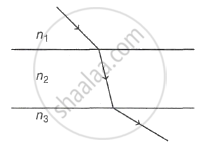Advertisements
Advertisements
प्रश्न
Answer the following question.
What is the advantage of having more than one pigment molecule in a photocenter?
उत्तर
Advantages of having more pigment molecules in a photo center are as follows:
- Having more than one pigment molecule in photocenter means more sunlight being captured and thus facilitating more effective light reaction.
- It will provide protection to chlorophyll molecule against photo-oxidation.
- More pigments will capture more energy to start the initial reactions, which is not possible by a single pigment.
APPEARS IN
संबंधित प्रश्न
A concave mirror of curvature 40 cm, used for shaving purposes produces image of double size as that of the object. Object distance must be ______.
Solve Numerical example.
A monochromatic ray of light strike the water (n = 4/3) surface in a cylindrical vessel at angle of incidence 53°. Depth of water is 36 cm. After striking the water surface, how long will the light take to reach the bottom of the vessel? [Angles of the most popular Pythagorean triangle of sides in the ratio 3:4:5 are nearly 37°, 53°, and 90°]
Distinguish between action spectrum and absorption spectrum.
Answer the following question.
Why is photolysis of water accompanied with non-cyclic photophosphorylation?
Light of wavelength 5000 A.U. falls on a plane reflecting surface. The frequency of reflected light is ______
Which of the following is not a property of light?
A ray of light is incident at an angle ion one face of prism of small angle A and emerges normally from the other surface. µ is the refractive index of the material of the prism. The angle of incidence is _____________.
When light enters glass from vacuum then the wavelength of light ______
In a compound microscope, let u0 and v0 be the object distance and image distance respectively. The objective of focal length f0 magnifies a tiny object into a real, inverted image. The linear magnification of the objective is ______.
A beam of light passes from medium 1 to medium 2 to medium 3 as shown in the diagram. What may be concluded about the three refractive indices n1, n2 and n3?

